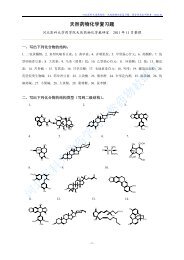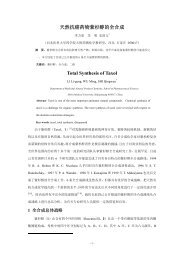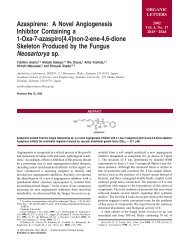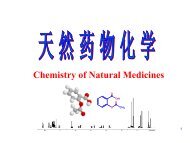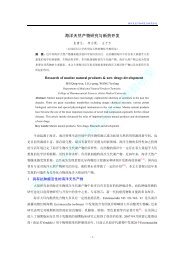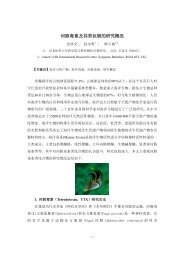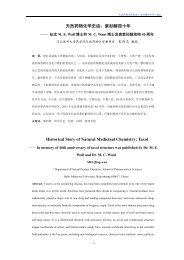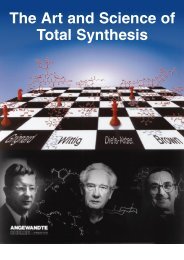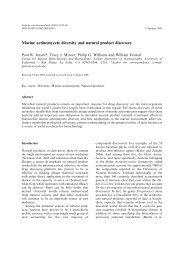Total Synthesis Highlights
Total Synthesis Highlights
Total Synthesis Highlights
You also want an ePaper? Increase the reach of your titles
YUMPU automatically turns print PDFs into web optimized ePapers that Google loves.
The ester 2 has a trans 6-5 ring fusion, whereas in the desired 3 the ring fusion is cis. This was<br />
easily corrected, as the 6-5 ring fusion is more stable cis. Acid-mediated dehydration to give the<br />
alkene proceeded with concomitant removal of the MOM protection. Osmylation followed by<br />
acetonide formation and subsequent oxidation gave the ketone, which was readily epimerized to<br />
10. The acetonide was designed to block H addition to the bottom side, so hydrogenation of 11<br />
would give the isopropyl group endo. In fact, hydrogenation led to the undesired exo isopropyl,<br />
but hydroboration proceeded from the exo face, leading to the desired 12.<br />
Hydrolysis of the acetonide followed by oxidation and bromination provided the ketone 13, which<br />
is itself a natural product, hamigeran A. Hydrolysis under aerobic conditions led first to<br />
decarboxylation, then to autooxidation, to give(-)-hamigeran B 3<br />
74. <strong>Synthesis</strong> of the Dendrobatid Alkaloid 251F<br />
The Dendrobatid “poison arrow” frogs of Central and South America exude a potent mixture of<br />
alkaloids from their skins. It was originally thought that the frogs biosynthesized these alkaloids,<br />
but it has since been shown that they are of dietary origin. The skin exudate of the Colombian frog<br />
Minyobates bombetes causes severe locomotor difficulties, muscle spasms and convulsions upon<br />
injection in mice. The major component of the alkaloid mixture is 251F 3. Jeff Aubé of the<br />
University of Kansas recently described (J. Am. Chem. Soc. 2004, 126, 5475.) the enantioselective<br />
total synthesis of 3. The key step in the synthesis was the cyclization of the keto azide 2.<br />
The ketone 1, with four ternary stereogenic centers in one cyclopentane ring, was a significant<br />
challenge for synthesis. A clever solution flowed from the idea of coupling a chiral Diels-Alder<br />
reaction with alkene metathesis. The relative and absolute configuration of 1 were set by the<br />
Diels-Alder cycloaddition of the acyl oxazolidine 4 to cyclopentadiene, to give 5. Homologation<br />
of 5 to the enone 6 set the stage for alkene metathesis, mediated by the Grubbs catalyst 7, to give<br />
1.



